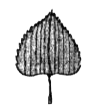Soha plucks a leaf of wheat plant. The venation she observes in this leaf is similar to which of the following kinds of leaf?




To determine the type of venation observed in a wheat plant leaf and find a similar type of leaf, we can follow these steps:
1. Identify the Plant Type:
- Wheat is classified as a monocot plant. Monocots are characterized by having one cotyledon.
2. Understand Venation Types:
- There are two main types of venation:
- Parallel Venation: Where the veins run parallel to each other.
- Reticulate Venation: Where the veins form a network or branching pattern.
3. Analyze Wheat Leaf Venation:
- In the case of wheat, the leaf exhibits parallel venation. This means that the veins in the leaf run in straight lines parallel to each other.
4. Compare with Other Leaves:
- To find a leaf with similar venation, we need to look for other monocot leaves, as they also exhibit parallel venation. Examples include leaves of plants like grass, lilies, or corn.
5. Choose the Correct Option:
- From the options provided, select the one that represents a leaf with parallel venation.
Conclusion:
- The venation observed in the wheat plant leaf is similar to that of other monocot leaves, which display parallel venation.
- Wheat is classified as a monocot plant. Monocots are characterized by having one cotyledon.
- There are two main types of venation:
- Parallel Venation: Where the veins run parallel to each other.
- Reticulate Venation: Where the veins form a network or branching pattern.
- In the case of wheat, the leaf exhibits parallel venation. This means that the veins in the leaf run in straight lines parallel to each other.
- To find a leaf with similar venation, we need to look for other monocot leaves, as they also exhibit parallel venation. Examples include leaves of plants like grass, lilies, or corn.
- From the options provided, select the one that represents a leaf with parallel venation.
- The venation observed in the wheat plant leaf is similar to that of other monocot leaves, which display parallel venation.
Topper's Solved these Questions
- STRUCTURE AND FUNCTIONS OF PLANT PARTSBOOK - BETOPPERSCHAPTER - STRUCTURE AND FUNCTIONS OF PLANT PARTSEXERCISE - SUMMATIVE WORKSHEET (MULTIPLE CHOICE QUESTIONS)
10 Videos
- STRUCTURE AND FUNCTIONS OF PLANT PARTSBOOK - BETOPPERSCHAPTER - STRUCTURE AND FUNCTIONS OF PLANT PARTSEXERCISE - SUMMATIVE WORKSHEET (FILL IN THE BLANKS)
20 Videos
- STRUCTURE AND FUNCTIONS OF PLANT PARTSBOOK - BETOPPERSCHAPTER - STRUCTURE AND FUNCTIONS OF PLANT PARTSEXERCISE - SUMMATIVE WORKSHEET (ODD ONE OUT)
5 Videos
- SOILBOOK - BETOPPERSCHAPTER - SOILEXERCISE - SUMMATIVE WORKSHEET
14 Videos
Similar Questions
Knowledge Check
Which of the following is broad leaf weed ?
AChenopodiumBConvalvulusCAmaranthusDall of the aboveWhich of the following is not part of a leaf?
ApedicelBLeaf baseCpetioleDLaminawhich one of the following is a modified leaf ?
ASweet potatoBGingerCOnionDCarrot
In the leaf of tobacco which of the following is found
View SolutionWhich of the following insects mimic a dry leaf?
View SolutionA dicot leaf with parallel venation is
View SolutionWhich of the following is not a characteristic of leaf?
View SolutionWhich of the following is not the modification of leaf?
View Solution
